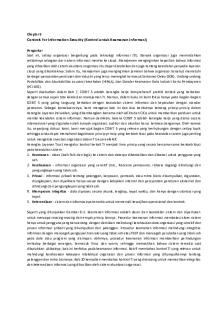Chapter 8 Metabolism - very thorough information PDF

| Title | Chapter 8 Metabolism - very thorough information |
|---|---|
| Author | Lakiaya Wright |
| Course | General Biology I |
| Institution | Valencia College |
| Pages | 1 |
| File Size | 93.2 KB |
| File Type | |
| Total Downloads | 59 |
| Total Views | 141 |
Summary
very thorough information...
Description
Name: Lakiaya Wright Teacher: Professor Castro Course: BSC-1010C-13795 Date:10/28/2020
Discussion: Ch 8 Metabolism 1. Explain the relationship between energy and work: Energy is defined as the ability to do work, or to create change. Energy exists in different forms. For example, electrical energy, light energy, and heat energy are all different types of energy. To appreciate the way energy flows into and out of biological systems, it is important to understand two of the physical laws that govern energy. 2. Differentiate between kinetic and potential energy: Kinetic Energy- Is when energy can be associated with the relative motion of objects. Potential Energy- An object not presently moving may still posses energy that is not kinetic is potential. 3. State the first and second laws of thermodynamics: 1st law “Energy can be transferred and transformed but cannot be created or destroyed”. 2nd law “every energy transfer or transformation increase in entropy of the universe”. 4. Define exergonic and endergonic reactions: Exergonic Reactions is a chemical reaction that proceeds with a net release of free energy that have a negative ∆G release free energy. This indicates a spontaneous reaction if the system is closed and initial and final temperatures are the same. Endergonic Reactions Is one that absorbs free energy from its surroundings. Because this kind of reactions essentially stores free energy in molecules (G increases), ∆G is positive. Such reactions are nonspontaneous, and the magnitude of ∆G is the quantity of energy required to drive the reaction. 5. Differentiate between catabolic and anabolic pathway: Anabolic pathways are those that require energy to synthesize larger molecules. Catabolic pathways are those that generate energy by breaking down larger molecules. Both types of pathways are required for maintaining the cell's energy balance. 6. Explain in general terms how cells obtain the energy to do cellular work: Are biological catalysts agents that speed the rate of a reaction but are unchanged by the reaction 7. Describe the structure of the nucleotide ATP: ATP is a nucleotide that consists of three main structures: the nitrogenous base, adenine; the sugar, ribose; and a chain of three phosphate groups bound to ribose. The phosphate tail of ATP is the actual power source which the cell taps. 8. Describe the function of enzymes in biological systems: Are biological catalysts agents that speed the rate of a reaction but are unchanged by the reaction 9. Describe the structure of enzymes: Enzymes structure are made up of α amino acids which are linked together via amide (peptide) bonds in a linear chain. This is the primary structure. The resulting amino acid chain is called a polypeptide or protein....
Similar Free PDFs

Chapter 5 - Microbial Metabolism
- 8 Pages

Chapter 5 Microbial Metabolism
- 11 Pages

Chapter 4: Cellular Metabolism
- 2 Pages

Chapter 5 . Metabolism Summary
- 3 Pages

8 Puzzle Problem Information
- 13 Pages

Chapter-8 - chapter 8
- 13 Pages

Glycogen metabolism
- 20 Pages
Popular Institutions
- Tinajero National High School - Annex
- Politeknik Caltex Riau
- Yokohama City University
- SGT University
- University of Al-Qadisiyah
- Divine Word College of Vigan
- Techniek College Rotterdam
- Universidade de Santiago
- Universiti Teknologi MARA Cawangan Johor Kampus Pasir Gudang
- Poltekkes Kemenkes Yogyakarta
- Baguio City National High School
- Colegio san marcos
- preparatoria uno
- Centro de Bachillerato Tecnológico Industrial y de Servicios No. 107
- Dalian Maritime University
- Quang Trung Secondary School
- Colegio Tecnológico en Informática
- Corporación Regional de Educación Superior
- Grupo CEDVA
- Dar Al Uloom University
- Centro de Estudios Preuniversitarios de la Universidad Nacional de Ingeniería
- 上智大学
- Aakash International School, Nuna Majara
- San Felipe Neri Catholic School
- Kang Chiao International School - New Taipei City
- Misamis Occidental National High School
- Institución Educativa Escuela Normal Juan Ladrilleros
- Kolehiyo ng Pantukan
- Batanes State College
- Instituto Continental
- Sekolah Menengah Kejuruan Kesehatan Kaltara (Tarakan)
- Colegio de La Inmaculada Concepcion - Cebu








